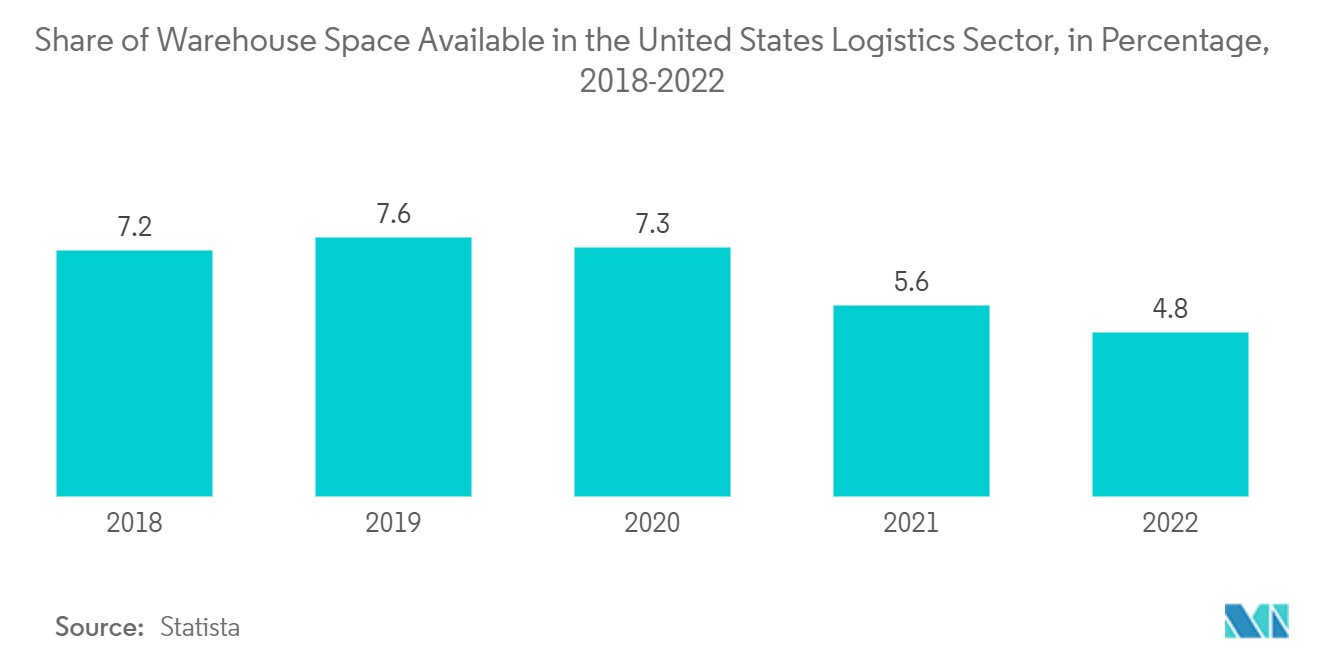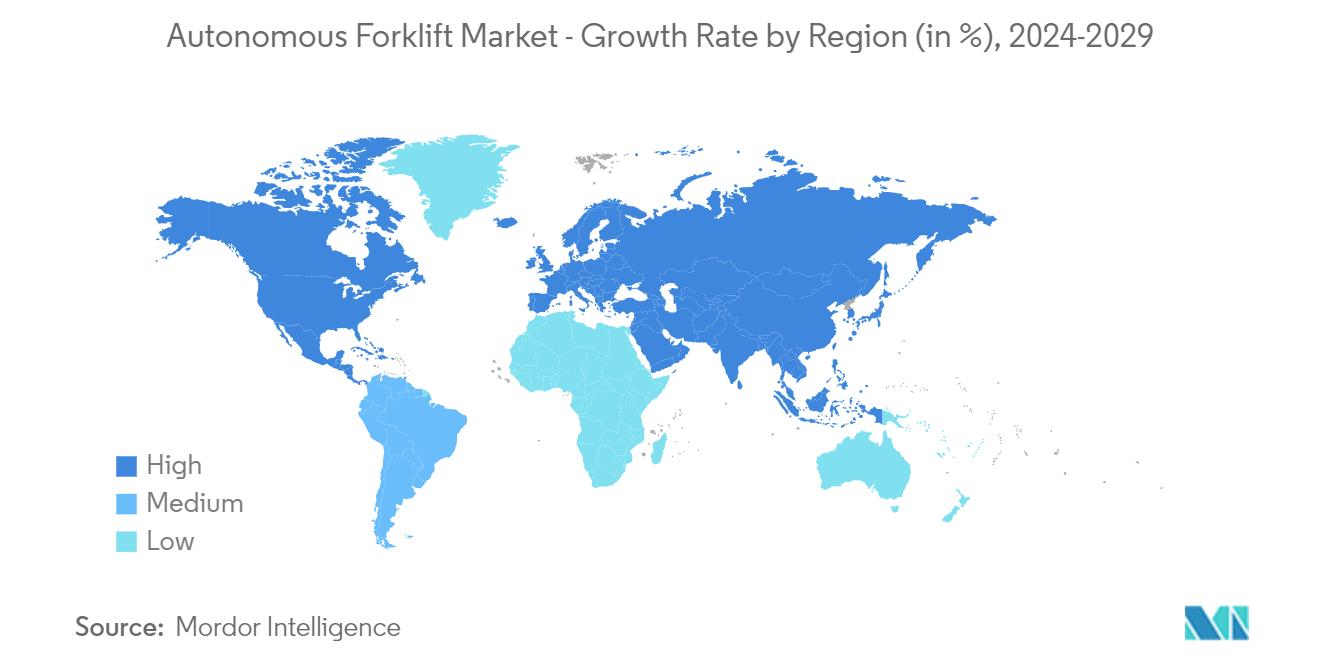Market Trends of Autonomous Forklift Industry
The Logistics and Warehousing Sector is Expected to Gain Traction Between 2024 and 2029
Increasing internet and smartphone penetration rates worldwide are assisting consumers in availing online mediums for daily purchases of essential products and groceries, which, in turn, is contributing to the growth of the e-commerce market. Therefore, there exists a massive demand for equipment and machinery deployed in warehousing and distribution centers that can help operators manage inventories and expedite the delivery process.
- According to the Indian Brand Equity Foundation (IBEF), India gained 125 million online shoppers between 2020 and 2023, with another 80 million online shoppers being expected by 2025.
- The number of e-commerce users in the United States touched 240.7 million in 2022 compared to 223.76 million in 2021, representing a Y-o-Y growth of 7.57% between 2021 and 2022.
- Similarly, the number of e-commerce users in Italy reached 22.04 million in 2022 compared to 19.98 million in 2021, recording a Y-o-Y growth of 10.3% between 2021 and 2022.
With the expanding e-commerce sector, there remains a massive demand for storage and warehousing facilities to ensure that products are being managed and disbursed promptly, which, in turn, positively impacts the demand for autonomous forklifts. The benefit of deploying driverless forklifts in these facilities is that they help in completing the overall loading/unloading process at a faster rate compared to traditional products. In recent years, owing to the shifting consumers' preference for availing eco-friendly products, the penetration of electric autonomous forklift rentals is witnessing surging growth.
- The industrial and logistics real estate investment in the Netherlands stood at EUR 5,150 million (USD 5,611 million) in 2022 compared to EUR 4,710 million (USD 5,131 million) in 2021, representing a Y-o-Y growth of 9.35%.
Further, the share of ready-to-occupy logistics space in the United States has decreased substantially in recent years, showcasing strong warehousing demand. In the last quarter of 2022, the availability of industrial and logistics real estate stood at 4.4%, down from 7.4% in Q4 2022.
Both the private and public players in the ecosystem are investing hefty sums in developing and expanding warehousing facilities worldwide, which is leading to the surging demand for advanced equipment, such as autonomous forklifts, that are to be deployed in these sites. Therefore, with the rising demand for warehousing facilities and the expanding e-commerce sector, there will exist a massive demand for autonomous forklifts between 2024 and 2029.

Asia-Pacific is Expected to be the Fastest Growing Market Between 2024 and 2029
Rising investments in construction projects, the expanding e-commerce and warehousing sector in the region, and growing industrial activities contribute to the demand for an autonomous forklift market in Asia-Pacific since these are extensively deployed on-site for transporting materials and loading/unloading products and commodities.
- In January 2024, Groundwork announced the commencement of construction of the largest Multimodal Logistics Park (MMLP) in South India on the northern outskirts of Bengaluru to provide a host of logistics, warehousing, and cold storage facilities that are aimed at reducing overall logistics costs from 13% to 9% making exports competitive. Further, the company stated that the logistics park will be spread across 400 acres and will have the capacity to handle 30 million metric tonnes of cargo by 2070.
- Mumbai, Chennai, and Delhi were the leading cities in India with the highest existing stock for warehousing in 2022. In Mumbai, the existing stock for warehousing touched 14.6 million square meters in 2022, followed by Delhi NCR, wherein the existing stock stood at 6.4 million square meters during the same period.
- According to the Japanese Ministry of Land, Infrastructure, Transport, and Tourism (MLIT), the area of class 1 to 3 regular warehouses in Japan reached 66.13 million square meters in 2022 compared to 61.61 million square meters in 2021, representing a Y-o-Y growth of 7.33% between 2021 and 2022.
The e-commerce sector in Asia-Pacific is expected to witness a rapid surge in the coming years, and therefore, operators in the region are extensively strategizing to expand their fleet to include advanced forklifts, which, in turn, is positively impacting the demand for autonomous forklifts. Although the deployment of autonomous forklifts across Asia-Pacific is still in its nascent phase, with the lowering cost and various domestic players integrating the ecosystem, there will exist a massive opportunity for the adoption of driverless forklifts. Apart from warehousing and distribution centers, these products are extensively utilized in industrial, manufacturing, and construction facilities for transporting materials, and hence, with the increasing government focus on enhancing the road transportation infrastructure across Asia-Pacific, the demand for autonomous forklifts is expected to showcase massive surge between 2024 and 2029.
- In December 2023, the Indian Road Transport Ministry proposed a program to build and widen around 41,000 km of national highways, including 15,000 km of high-speed (access-controlled) corridors by 2031-32 to double the average travel speed at national highways. As per the proposal, an estimated investment of INR 19.5 lakh crore (USD 234.9 billion) will be required for the completion of this project.
- In April 2023, the Chinese government announced the commencement of several new highway projects across the country. One such development project worth USD 1.07 billion will connect the Yongjing and Jingping regions, stretching 41 Km and designed to support travel speeds up to 80 Km/hr with two lanes in either direction.
Furthermore, owing to the government's aggressive focus on promoting the adoption of electric equipment in fleets, there will exist a surging demand for electric autonomous forklifts across Asia-Pacific. Companies such as BYD are collaborating with international players to integrate advanced navigation technology and sensors in their forklift products to ensure these models can be operated without manual intervention. With the increasing investments to develop and integrate cutting-edge technological solutions, the autonomous forklift market is anticipated to showcase a rapid surge from 2024 to 2029.


